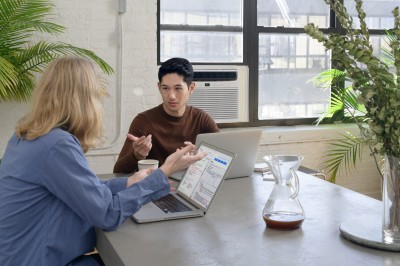Enterprise Product Management: 5 Struggles Of Big Product Teams and Their Solutions

The role of product manager is both highly rewarding and really quite complex. Not only are there general challenges that all product managers face — prioritization, in some companies tight deadlines, technical issues — but in addition to that, each product team comes with unique challenges that require unique solutions.
Take enterprise product teams, for example. Unless you’ve worked as an enterprise product manager or been part of an enterprise product team, you might not understand the day-to-day challenges that developing an enterprise product can present.
In this post, we're going to explore these challenges — and share our best practices to help you overcome them.
What is an enterprise product manager?
Before we get too far into that, however, let's look at what a product manager is so that we can better understand why these challenges can hit so hard.
Generally speaking, an enterprise product manager is a PM developing a product for which large enterprise businesses of 1000+ employees are the end user. You might also hear an enterprise PM described as a product manager within a large business, but this is less common.
When a product manager is developing an enterprise product — aimed at enterprise users — they have all the same responsibilities as other PMs, but with a twist. While enterprise PMs also research their market, prioritize features, manage resources, and more, they do so while serving any number of different stakeholders. An enterprise product might be used by several different departments within the business, or it might be required to perform super-specific functions at scale.
So now that we’re starting to see just how complex that can be, let’s look at five challenges of enterprise product teams in more detail.

5 challenges of enterprise product teams
Below is a breakdown of the various challenges that product managers and their teams face. While there are a lot, each of these challenges can be approached with a strategic and sustainable solution.
A large number of stakeholders
One of the key challenges that enterprise product teams face is having a large number of stakeholders. While this can be said for all PMs, it’s particularly true in an enterprise environment for the reasons we outlined above.
Enterprise product teams have to understand, cater for, and balance the needs and wants of a range of different users within the customer’s organization. While a product manager developing a b2c product — let’s say a map app, for example — may have one particular ‘job’ they are helping users achieve, enterprise PMs might be building software that encompasses multiple user journeys and buyer personas.
If the product team is also involved in product marketing, they’ll need to understand how to appeal to the gatekeepers (C-Level, procurement, etc) who will purchase the product as well.
Big-ticket clients
Large enterprise customers tend to come with strict needs and several demands.
When working with these big-ticket clients, there is a level of pressure (sometimes unspoken) to say yes to every request. Otherwise, there is the fear of losing the client. This concern can lead to even more pressure being put on you and your enterprise product team, creating more complications around how to move forward.
Lack of agility
During the development of a product, the ability to make changes and adapt is key. It allows you to take in and respond to feedback, solve unexpected problems, and refine your product even up to the later stages of development.
The issue is, when working in an enterprise environment, your agility is usually pretty limited. Like a large oil tanker, enterprise businesses are slow to make adjustments. And the larger the adjustment, the longer it will take to implement.
This means that you'll need to look as far ahead as accurately and as much as possible. Otherwise, you could end up with serious problems that are very difficult to correct.

Market validation can be slow
Market validation is a crucial part of the product development process. It lets you and your team know if you're on the right track at various stages of development. This in turn clues you into changes that you need to make, which as we just discussed, is very important, especially in an enterprise setting.
The challenge with developing an enterprise product, though, is that market validation can be slow. There is usually a lengthy process to put an early product in a user’s hands, as there is a lot of internal approval that needs to take place.
With all the tight deadlines and high-pressure demands your team can receive, the extra time that market validation takes can seriously add up.
Aggressive timelines
Another challenge that enterprise product teams typically face is aggressive deadlines. And as you may have rightly predicted, this compounds every single one of the challenges we've mentioned thus far.
Harsh deadlines limit your agility, give you less preparation time, and can, in general, lead to unsuccessful product development cycles. It's up to your team to learn to work under the pressure, learn from past mistakes, and sidesteps potential pitfalls at every turn.
How to succeed as an enterprise product team
Now that we've covered most of the challenges enterprise product teams and product managers are likely to face, let's look at a few ways that you can overcome these challenges. By implementing these strategies, you can better prevent the challenges described above and mitigate their effects.
Prioritize the needs of several personas
First, enterprise PMs can work to prioritize the needs of several personas at once. Rather than leading with one persona, it's best to aim for a broader variety when working with enterprise-scale products.
What does your product need to do to support multiple user roles? Which departments will use your product most often and what are their absolute essential needs?
How will you appeal to the gatekeeper or buyer? What do they need to know your product can do in order to pay for the software?
Balancing these (sometimes contradictory) motivations can be challenging, but prioritization frameworks can really help.
Consider a direct selling strategy to focus your development efforts
By trying to do everything with your product, you risk truly delivering on nothing.
In an attempt to serve everyone’s needs and say ‘yes’ to the demands of each big-ticket client, you could end up with a product that’s bloated with features and unpleasant to use.
One solution could be to adopt a direct selling strategy; making your product(s) available via subscription or through individual licenses. By reaching out directly to potential enterprise customers and asking them what they need your product to do, you can co-create software that does what it has to for the people who are willing to buy.

Take advantage of cross-functional collaboration
Speaking of which, our third tip for enterprise product teams is to take advantage of cross-functional collaboration. That means working closely with all of the stakeholders and teams working to bring your product to life. Collaborate with your marketers, developers, stakeholders, and testers as often as you can.
It's the best way to mitigate the potential effects of slow market validation and lack of agility.
Learn all there is to know about product management challenges
For more in-depth learning and insights on overcoming product management challenges with product management best practices, request a copy of airfocus’s How To Succeed as a Modern Product Manager guide or eBook called All You Need To Know About Product Management.
It covers everything product managers need to know to succeed with enterprise products and pressures. So grab your copy today.
Extra: 5 extra challenges and how to solve them
As much as we would like an easy ride, projects will continue to throw challenges your way. Here are a few more common enterprise product management challenges, with tips to help you push through.
Effective communication
Communication is crucial in all businesses, but it gets much more complex to keep everyone in the loop when it comes to enterprise product management. You have to consider the multiple stakeholders, teams, and departments involved. That’s assuming you’re not also responsible for keeping customers looped in on the development process, adding yet another communication channel to maintain.
Poor communication is one of the biggest problems an organization has to overcome. Many feel like it’s something that just happens naturally, but teams need to work hard to maintain communication. It can lead to misunderstandings, delays, and conflicting priorities if they don't.
Strategies for improving communication include:
Establishing clear communication channels and protocols within the product team and with stakeholders.
Conducting regular meetings, status updates, and progress reports to keep everyone informed and aligned.
Using collaboration tools and project management software to facilitate effective communication and documentation.
Resource management
While Enterprise teams seem to have a massive resource pool to pull from, product teams still often have to manage limited resources, including budget, time, and human resources. This could be due to a smaller budget for a particular project, or an organization-wide effort to reduce resource usage.
Even with a big budget, effectively allocating and managing resources is essential to deliver the product on time and within budget.
Solutions for resource management challenges include:
Conducting thorough resource planning and estimation to identify potential bottlenecks and allocate resources accordingly.
Prioritizing features and tasks based on their impact and value to the business and customers.
Collaborating with stakeholders and executives to secure necessary resources and support for the product development process.
User adoption
A key struggle for product teams is making something powerful enough to handle every customer’s needs without making it difficult for new users to get to grips with. This is especially important for major product updates.
Big updates have a strong chance of disrupting your user experience. Not only do you need to worry about new users, your existing users will feel equally as new to the product. To ensure success, you need to make sure the user adoption process is seamless.
Strategies for addressing user adoption challenges include:
Conducting user research and gathering feedback during development to understand user needs and preferences.
Providing comprehensive training, documentation, and support materials to assist users in transitioning to the new product.
Developing change management plans to address resistance and facilitate a smooth transition for users and stakeholders.
Continuous improvement and iteration
Enterprise products are rarely "finished" after their initial release, and SaaS products will never be finished until they are discontinued.
Agile methodologies have infused the idea of continuous improvement and iteration into our workflows, and embracing those ideas now is more important than ever. Teams can meet evolving user needs, address market changes, and stay ahead of the competition through continuous improvement and iteration.
Strategies for enabling continuous improvement include:
Implementing feedback loops and gathering user feedback through surveys, user testing, and customer support interactions.
Analyzing product analytics and metrics to identify areas for improvement and prioritizing enhancements.
Iterating on the product roadmap and incorporating new features and updates based on user feedback and market trends.
Building strategic partnerships
Strategic partnerships are extremely valuable for enterprise product managers. They offer the chance for personal development, and Enterprise product managers can benefit from establishing strategic alliances with other organizations, vendors, or technology providers. These partnerships can help enhance product capabilities, access new markets, and leverage new expertise that could level up your product or workflow.
Strategies for building strategic partnerships include:
Identifying potential partners aligning with the product's vision, target market, and business objectives.
Building relationships with key stakeholders in partner organizations through networking, conferences, and industry events.
Collaborating closely with partners to integrate their solutions, leverage their expertise, and jointly address market challenges.

Malte Scholz

Read also

Experience the new way of doing product management

Experience the new way of doing product management







